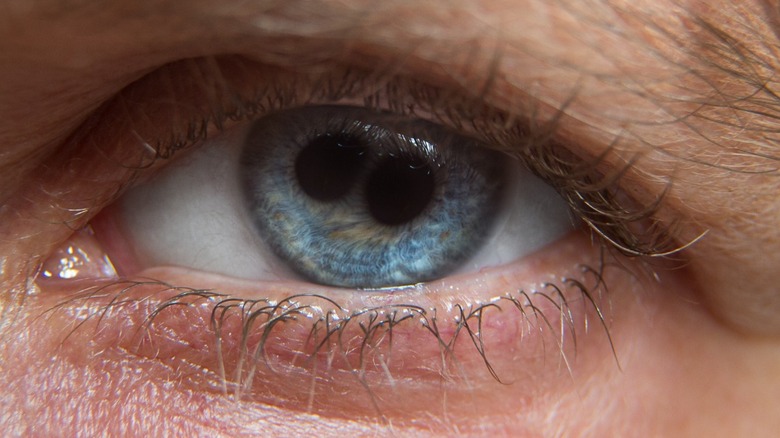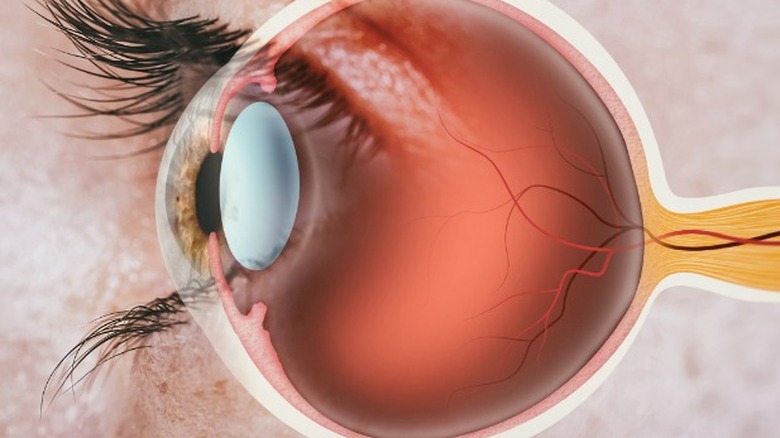What Does It Mean If You Have Two Pupils In One Eye?
They say that seeing is believing. The human eye enables our wonderful and awe-inspiring sense of sight. Given healthy development and no complications for injuries, we are blessed with two eyes that, together with the brain, help to create our literal world view. The human eye is an intricate organ that filters light through a series of structures, then sends electrical signals to the brain (via National Eye Institute).
Some of the core features of the eye include the cornea and the pupil. The cornea is the outer layer of the eye that's clear. Its dome shape helps the eye focus by bending light. Some of the most common vision problems come from irregularities in the cornea. For example, corneal astigmatism, or when the cornea has an irregular cone-like shape, can cause nearsightedness and or farsightedness. Then there's the pupil, which is black opening in the middle of the eye. The pupil adjusts to light intensity. One extremely rare condition can actually cause you to have two pupils in one eye. Here's everything you need to know about polycoria and the other condition that it is often confused for, known as pseudopolycoria.
What is polycoria?
Polycoria is a rare eye condition that can affect either one or both of the pupils, reports Healthline. Though it can present during youth, polycoria may not cause vision issues or be diagnosed until adulthood. If you have polycoria, then one or both eyes will have two or more pupils in the affected eye(s). That means that each pupil contains a complete sphincter muscle that constricts and dilates. You may notice a layer of iris tissue between the pupils, or an elongated shape of the pupils. The condition may be caused by another condition such as glaucoma, irregular eye development, or a detached retina.
Polycoria can negatively affect your vision, which may be in part due to the iris developing multiple sets of muscles. Since the iris surrounds the pupil, in polycoria the multiple sets of pupils and irises can limit the amount of light that enters the eye, which can weaken your vision. The irregular pupils can also make it harder to focus. The symptoms of polycoria can range from blurred vision to weakened or even double vision in the affected eye. You may also experience symptoms like trouble dealing with strong or dazzling light that glares off of surfaces.
Polycoria: treatments and outlook
Some people who live with polycoria do not experience any significant vision problems and find that the eye condition does not alter their daily lives. However, others who have symptoms like blurry vision or an inability to focus their vision may seek treatment. Common treatments for polycoria include a few types of eye surgeries (per Vision Center). One procedure is known as pupilloplasty. During the surgery, the patient is placed under a type of local anesthesia that blocks the nerve of the area behind the eye. Additionally, the surgeon dilates the pupils with a medical eye drop. Then the surgeon then makes an incision in the iris tissue and takes out the layer of iris tissue between the pupils. In one case of polycoria, pupilloplasty successfully treated the condition and bettered the vision of the patient (via Arquivos Brasileiros de Oftalmologia). Because polycoria is so uncommon, however, it's hard to determine if the surgery would be equally successful on other patients.
Another surgical option utilizes a type of polypropylene suture. The specialized suture is performed using a thread with a needle at each end, and helps stabilize the lens that is implanted in the eye. In plain language, your eye gets stitches. It is important to go to your eye doctor to properly diagnose polycoria, because the condition is very rare and often confused with another condition known as pseudopolycoria.
What is pseudopolycoria?
According to Healthline, pseudopolycoria is often confused with polycoria because the patient seemingly has two pupils in their affected eye. But pseudopolycoria is actually an abnormality where holes in the iris mimic the look of multiple pupils. Notably, unlike with true polycoria, the holes in the iris do not have distinct sphincter muscles, which is what makes the condition "pseudo." Therefore, the defect in the eye is not related to the development of multiple pupils that dilate and constrict — which is the case in polycoria.
Pseudopolycoria usually does not cause any vision problems, but it is associated with several conditions like juvenile glaucoma, posterior polymorphous, dystrophy, and Seckel syndrome (via Vision Center). However, a 2021 case study published in the American Journal of Ophthalmology Case Reports details a woman who complained of issues with light sensitivity and had developed pseudopolycoria from an iris surgery. The patient's pseudopolycoria symptoms were relieved with daily use of a contact lens.




